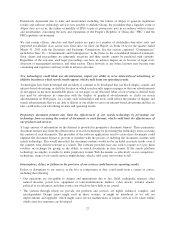Yahoo 2011 Annual Report Download - page 30
Download and view the complete annual report
Please find page 30 of the 2011 Yahoo annual report below. You can navigate through the pages in the report by either clicking on the pages listed below, or by using the keyword search tool below to find specific information within the annual report.• Despite our implementation of network security measures, our servers are vulnerable to computer viruses,
worms, hacking, physical and electronic break-ins, router disruption, sabotage or espionage, and other
disruptions from unauthorized access and tampering, as well as coordinated denial-of-service attacks. We may
not be in a position to promptly address attacks or to implement adequate preventative measures if we are
unable to immediately detect such attacks. Such events could result in large expenditures to investigate or
remediate, to recover data, to repair or replace networks or information systems, including changes to security
measures, to deploy additional personnel, to defend litigation or to protect against similar future events, and
may cause damage to our reputation or loss of revenue. We distribute servers among data centers around the
world to create redundancies; however, we do not have multiple site capacity for all of our services and some
of our systems are not fully redundant in the event of delays or disruptions to service. As not all of our systems
are fully redundant, some data or systems may not be fully recoverable after such events.
• We rely on third-party providers for our principal Internet connections and co-location of a significant portion
of our data servers, as well as for our payment processing capabilities and key components or features of our
search, e-mail and VOIP services, news, stock quote and other content delivery, chat services, mapping,
streaming, geo-targeting, music, games, and other services. We have little or no control over these third-party
providers. Any disruption of the services they provide us or any failure of these third-party providers to handle
higher volumes of use could, in turn, cause delays or disruptions in our services and loss of revenue. In
addition, if our agreements with these third-party providers are terminated for any reason, we might not have a
readily available alternative.
Prolonged delays or disruptions to our service could result in a loss of users, damage to our brands, legal costs or
liability, and harm to our operating results.
If we or our third-party service provider fail to prevent click fraud or choose to manage traffic quality in a way
that advertisers find unsatisfactory, our profitability may decline.
A portion of our display and search revenue comes from advertisers that pay for advertising on a price-per-click
basis, meaning that the advertisers pay a fee every time a user clicks on their advertising. This pricing model can
be vulnerable to so-called “click fraud,” which occurs when clicks are submitted on ads by a user who is
motivated by reasons other than genuine interest in the subject of the ad. On Yahoo! Properties and Affiliate
sites, we or our third-party service provider may be exposed to the risk of click fraud or other clicks or
conversions that advertisers may perceive as undesirable. If fraudulent or other malicious activity is perpetrated
by others and we or our third-party service provider are unable to detect and prevent it, or choose to manage
traffic quality in a way that advertisers find unsatisfactory, the affected advertisers may experience or perceive a
reduced return on their investment in our advertising programs which could lead the advertisers to become
dissatisfied with our advertising programs and they might refuse to pay, demand refunds, or withdraw future
business. Undetected click fraud could damage our brands and lead to a loss of advertisers and revenue.
Moreover, advertiser dissatisfaction has led to litigation alleging click fraud and other types of traffic quality-
related claims and could potentially lead to further litigation against us or our third-party provider or government
regulation of advertising. Advertisers may also be issued refunds or credits as a result of such activity. Any
increase in costs due to any such litigation, government regulation or legislation, or refunds or credits could
negatively impact our profitability.
We are involved in legal proceedings that may result in adverse outcomes.
We are regularly involved in claims, suits, government investigations, and proceedings arising from the ordinary
course of our business, including actions with respect to intellectual property claims, privacy, data protection or
law enforcement matters, tax matters, labor and employment claims, commercial claims, as well as actions
involving content generated by our users, stockholder derivative actions, purported class action lawsuits, and
other matters. Such claims, suits, government investigations, and proceedings are inherently uncertain and their
results cannot be predicted with certainty. Regardless of the outcome, such legal proceedings can have an adverse
impact on us because of legal costs, diversion of management and other personnel, and other factors. In addition,
28
























